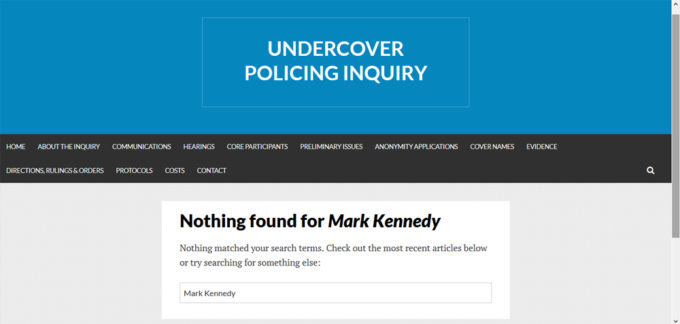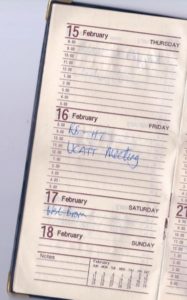The Secret Public Inquiry

The public inquiry into political undercover policing is in crisis, but has it ever been functional? It is as if they want to technically publish information whilst keeping it effectively secret.
Despite being set up more than three years ago with a projected finishing date of 2018, the Undercover Policing Inquiry is still in its preliminary stages. This waiting period has been so long that we have seen key figures die, including two former Home Secretaries, a former Metropolitan Police Commissioner, core participant victims of spycops and the Chair of the Inquiry itself, Lord Pitchford.
MITTING THE POINT
Pitchford promised to have ‘a presumption for openness’. There was alarm that the new choice of Chair, Sir John Mitting, would incline the opposite way due to his background in secret courts that almost invariably comply with government surveillance agencies.
The fears were well-founded, and a majority of the victims given core participant status at the Inquiry appealed for change in November 2017.
‘We are rapidly losing confidence in the Inquiry and in the abilities of John Mitting. He is rowing back on commitments made by the previous Chair, Christopher Pitchford, who stated the inquiry’s priority is to discover the truth and recognised the importance of hearing from both officers and their victims along with the need for this to be done in public as far as possible.’
It was ignored.
Mitting has shown himself to be gullible, taking police assertions at face value despite the fact that the Inquiry is into wrongdoing by trained police liars.
Last month victims and their lawyers walked out of a preliminary hearing on granting officers anonymity, saying:
‘We are not prepared actively to participate in a process where the presence of our clients is pure window dressing, lacking all substance, lacking all meaning and which would achieve absolutely nothing other than lending this process the legitimacy that it doesn’t have and doesn’t deserve.’
Victims are desperate for the Inquiry to fulfil its purpose. Keenly aware that the Met would like nothing more than a boycott that let them protect their secrets, the walkout was not a permanent move. Rather, it is an act of desperation as the victims’ good faith has been eroded by a process that goes out of its way to ignore them.
We want to tell our stories of being spied upon, but we cannot do it until we all know which of our friends and comrades was actually a police spy. We come eager to participate but the Inquiry’s acquiescence to police demands for secrecy means we are blindfolded and hogtied.
Stephen Lawrence’s father Neville has declared his loss of faith in Mitting and the Inquiry, and Doreen Lawrence has threatened to boycott the entire process if Mitting stays in charge.
PROTECTING THE GUILTY
Mitting grants anonymity to undercover officers even when the ‘independent risk assessor’ (a fellow police officer) says the risk of harm if they are named is low.
A few days ago we learned that officer HN15 – whose risk assessor said the danger of harm is high – is in fact Mark Jenner. He has had his real and cover names in the mainstream media along with his photo for over five years without, as far as we know, coming to any harm.
How can other officers’ risk assessments still be taken seriously? How can we trust in a Chair who believes such twaddle and then acts to shield abusers from accountability?
Last week, thirteen women deceived into relationships by spycops have demanded change from the Home Secretary.
‘Andrea‘ explained:
‘the Chair holds the rights of perpetrators in higher regard than the rights of victims. He clearly sees the officers’ human rights as sacrosanct, withholding the names of the spycops who invaded our homes, our families and our intimate lives…
‘Secrecy pervades this so-called ‘public’ inquiry, where officers who abused our rights are granted private hearings with the Chair to convince him to protect their privacy.’
But the Inquiry’s bunker attitude pre-dates Mitting’s appointment and goes beyond what he makes rulings on.
PUBLIC HEARINGS TURNING THE PUBLIC AWAY
The hearings have been held in the Royal Courts of Justice, with a public gallery that can’t quite squeeze 100 people in. With 200 significantly affected victims designated as core participants, most of them are physically prevented from attending the hearings, even before any of the wider public want to attend.
So far, only one preliminary hearing has had to turn people away – perhaps because the Inquiry won’t cover travel costs for victims who want to attend – but that will surely increase as the Inquiry moves towards hearing evidence.
Last month’s hearing took place on the same day as one for the Grenfell Tower inquiry. The Grenfell one was livestreamed, but the spycops Inquiry chooses not to let the world see what it is doing. The best it does is issue a transcript a day or two later in a bizarrely formatted PDF.
PUBLICATION UNSEEN
Much of the Undercover Policing Inquiry website is pages with links to dozens of PDFs bearing uninformative titles like ‘Detailed consultation document,’ ‘Chairman’s note on risk assessments,’ and ‘Ruling on undertakings’.
When scrolling through the list – one page is already at 66 different PDFs, some with the same name as each other – bear in mind that the Inquiry process hasn’t properly begun and the site is a small fraction of the size that it will end up.
A huge proportion of the PDFs on the site are ‘flat’, ie made of pictures of documents rather than text, which means they can’t be wordsearched and the contents won’t appear in websearches.
The search function on the website doesn’t assist. It claims there is nothing on the site about undercover officer Mark Kennedy.

A search of the site via Google turns up 56 results.

NAMING THE OFFICERS, A BIT
There was some hope of relief when they published a page listing undercover officers. However, that only lists four items of information about each officer:
- Cover name
- Herne nominal (without explaining what the term means)
- Groups they infiltrated
- Years of deployment
As ‘Alison‘, who was deceived into a relationship by a man she knew as Mark Cassidy said:
‘There is no restriction order on his real name: Mark Jenner. Yet his real name – and the real names of other confirmed officers – are not listed on this table, making it hard for the public to keep track of who’s who. It feels as if they’re always trying to keep as much hidden as possible.’
There is no link to an officer’s statements, independent assessments or anything else that is buried elsewhere on the site.
For the officers as yet unnamed, there is a link to one document that includes a ruling about them. Once the officer is named, they remove that one link and leave the reader with nothing but the four categories.

Page from undercover officer Mark Jenner’s 1996 diary, showing his attendance at a UCATT meeting
Even within that, the information is incomplete. Looking at the groups they infiltrated, they average less than two per officer. The Inquiry has previously admitted that more than 1,000 groups were spied on which, divided by the number of officers, means it must average as at least seven each. Every infiltrated group has a right to know. Why can’t we see the full list?
With the named officers, we can even name some of the other unmentioned groups they infiltrated, yet the Inquiry won’t admit it.
Whistleblower officer Peter Francis has publicly said his list is incomplete, as it omits Kingsway College Anti Fascist Group, which became Movement for Justice whilst he was infiltrating it.
Mark Jenner’s list doesn’t mention anything to do with trade unions, yet he was known to be a member of construction union UCATT and targeted other unions including the RMT, Unison, CPSA and TGWU. He was also a regular at meetings and on picket lines.
NO RESPONSE
The list of officers is incomplete in other ways. The section on those whose cover names won’t be published (‘Table Three : Where The Cover Name is Restricted’) only has has three officers, code-numbered HN7, HN123 and HN333.
It does not include others who belong in it, for example, HN23, HN40, HN58 and HN241 who were decided upon on 20 February 2018.
This is not a matter of the page not being updated, as ‘Table Two: Where the cover name is not known’ includes officers who were decided on in the same ruling (HN322 and HN348).
We emailed the Inquiry about this on 18 March. They have ignored it.
Trying to contact them on social media would be equally futile as their Twitter bio specifically says:
‘Tweets will not be responded to.’
END THE CULTURE OF SECRECY
The Undercover Policing Inquiry has already cost over £9m and despite its glacial pace, exclusion and secrecy, it insists it does not need extra staff. If it believes it is competent, that implies it is this way by design.
This is not just an overpaid underskilled worker making a bad website. The Inquiry site, the one-way social media and the refusal to livestream hearings are all online symptoms of a wider fundamental belief that the Inquiry does not have to properly engage with the public. The only substantial information it has given has been about officers already exposed by the people who were spied on.
Mitting has had more secret hearings than public. He not only refuses to answer key questions but rebuffs requests to explain his refusal, saying ‘I know more than you do’.
It is all an extension of his and the Inquiry’s belief in themselves as establishment overseers, which gives the process an inflated trust in the police whose wrongdoing the Inquiry is supposed to expose.
Enough is enough. The clue is in the name – it is a public inquiry. It takes the public’s money, it exists to make public the truth about the abuses of Britain’s political secret police. Nothing less will do.
